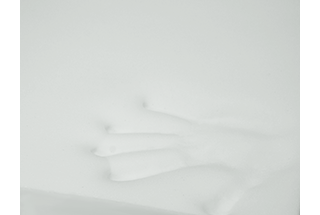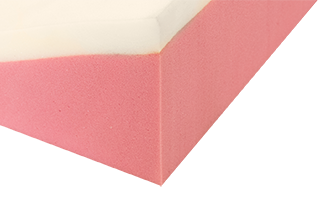Sonnet 30 Degree Positioning Wedge
Sonnet Positioning Wedge
The Sonnet Positioning Wedge is an aid to reduce pressure on existing pressure injuries or vulnerable skin areas by elevating them away from the support surface. It is the ideal accessory to achieve 30° side-lying positioning as recommended in clinical best practice publications. Soft and confirming foams provide comfort whilst maintaining sufficient structure and postural support. The unique non-slip base helps maintain position and prevent sliding.
Features

AIROFORM MEMORY IMMERSION INTERFACE
- High Temperature Stability to deliver consistent immersion, performance and comfort
- Maximises Patient contact with Support Surfaces Providing Pressure Redistribution
- Alleviates localised pressure points
- Depth calibrated to maximise functionality and patient mobility
- Visco-elastic/Memory Foam cell structure provides low-shear surface
- Firmness: Soft

SUPPORTIVE FOUNDATION LAYER
- Delivers excellent postural comfort
- High quality, excellent durability

FULLY SEALED & ENCLOSED ADVANTIFLEX PRESSURE CARE COVER W/NON-SLIP BASE
- Advantiflex PU1100 Pressure Care Polyurethane Upper Material: 4-Way Stretch, Vapour Permeable, Blue
- Non-Slip Polyurethane Waterproof Base: Provides excellent grip, prevents sliding, improves safety, alternative to Velcro!
- Construction: Fully sealed – no zipper, High frequency sealed and welded seams
- Learn more about Advantiflex
About the Sonnet Positioning Wedge
Pressure Relieving Device

Airoform Immersion Foam

Anatomical Support

Excellent Immersion

Gentle Care
IMPORTANCE OF POSITIONING
According to the Prevention and Treatment of Pressure Injuries: Clinical Practice Guideline, The International Guideline 2019, Repositioning and mobilizing individuals is an important component in the prevention of pressure injuries. The underlying cause and formation of pressure injuries is multifaceted; however, by definition, pressure injuries cannot form without loading, or pressure, on tissue. Extended periods of lying on a particular part of the body and failure to redistribute the pressure on the body surface can result in sustained deformation of soft tissues and, ultimately, in tissue damage.
Reposition the individual in such a way that optimal offloading of all bony prominences and maximum redistribution of pressure is achieved.
Implementation considerations:
- Check all pressure points when repositioning the individual to ensure that pressure has been adequately offloaded according to repositioning goals
- When repositioning individuals in the lateral side-lying position, offload the sacrococcygeal area without placing pressure on the trochanter
- Teach individuals who are able to provide some or all of their own pressure relief to reposition correctly and to do ‘pressure relief lifts’ or other pressure relieving maneuvers as appropriate
- Pay particular attention to the individual’s heels, which can be inadvertently exposed to continuous pressure even when the individual is repositioned frequently.
- In individuals who are sedated and ventilated, In particular neonates and infants, frequently reposition the head
- Avoid positioning the individual directly onto medical devices, such as tubes.
- Avoid positioning the individual on bony prominences with existing non-blanchable erythema
Reposition the individual to relieve or redistribute pressure using manual handling techniques and equipment that reduce shear and friction.

30° SIDE-LYING
Manual repositioning of patients by nursing staff is a recognised technique for preventing pressure injury formation. The 30° tilt is a method of positioning patients to reduce the contact pressure between the patient and the support surface, especially over high risk areas. The 30° tilt is also used to enhance patient comfort and relieve pain. Positioning devices should be used with, and not in place of, an appropriate pressure reducing support surface/mattress and in line with other pressure injury prevention protocols.
Recommendations state 30° Side Lying should alternate from the right side, the back and left side to prevent pressure, sliding and shear-related injury. Do not place clients directly on their trochanter.

HYGIENIC
An external device such as a positioning wedge must meet all the same inflection control standards as a support surface. Forté Sonnet Pressure Relieving Devices have high frequency welded seams (as opposed to sewn) and are wipe-clean and waterproof to meet infection control requirements for the facility environment. Welded seams prevent seepage of fluid through open, absorbent sewn seams.
In addition to the cover, foams used by Forté for the Sonnet Pressure Relieving Devices are specifically formulated for use within high humidity applications, typical within Hospital applications. ‘Humidity’ treatment ensures that the structural integrity of the foams remains within conditions that would otherwise have a significant degrading effect on foam performance. It also ensures postural support is maintained for comfort and prevents excessive pressure forces because of foam collapse. It is crucial to pressure injury prevention that the foam maintains its support to prevent a ‘bottoming out’ effect and ensure immersion and envelopment. Foams are also treated with Eversheild Anti-Microbial protection to prevent the growth of mould and bacteria. Maintaining healthy conditions within the foams reduces risk of infection control, cross patient contamination and mould.

VERSATILITY BY BEING AUSTRALIAN MADE
Australian made by Forté Healthcare in Armidale NSW, the Sonnet Pressure Relieving Devices are synonymous with quality, performance, longevity, and functionality and is trusted by leading Hospitals and healthcare professionals to deliver clinical results and positive outcomes.
Forté manufactures Sonnet devices to order which means they can be customised in size and configuration to suit a specific individual. Each patient has different anatomy which means one device is not always effective for all individuals.
Why is it important to purchase Australian made products?
By purchasing products from Forté you are investing in the future of pressure injury prevention in Australia, creating regional jobs and boosting our economy for the better of everyone. Australian Made for Australian Care.

Manufacturing
Leveraging clinical expertise, with leading raw material technology and in-house manufacturing capabilities Forté Healthcare ensures optimal outcomes for pressure injury prevention, infection control and patient comfort.

Hear what Health Professionals say About Forté Healthcare Mattresses…

You’re Covered by Forté Healthcare’s ‘Successful Solution Guarantee’
At Forté Healthcare, we are so confident in the care and performance our support surfaces deliver, that we back our products and expertise with our ‘Successful Solution Guarantee’.
Here’s how it works:
Our team of specialists will help you navigate our product range to correctly match our support surfaces with your care environment and patient risk profile. This ensures you achieve the highest levels of patient care and pressure injury prevention.
If, for whatever reason the product we recommend isn’t helping you achieve the outcome you expected, we’ll work with you until it is. And in the unlikely event we still cannot provide the right solution.
We’ll refund you 100% of the charges to date.














